
Papal Coinage
.pdf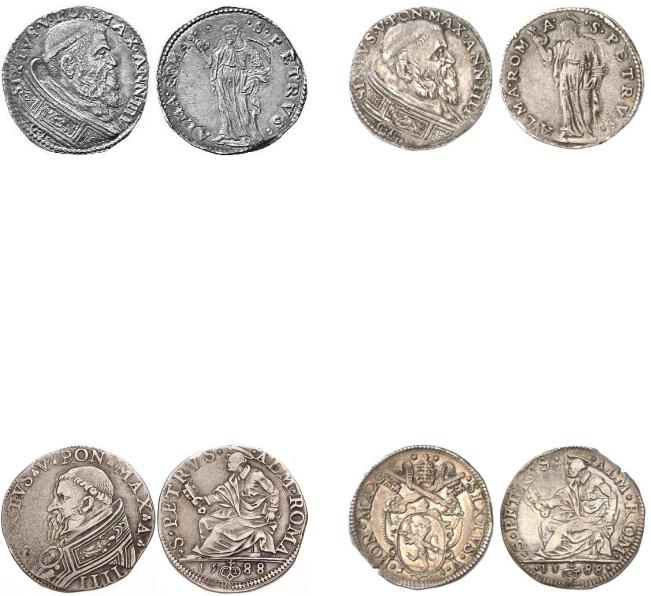
PAPAL COINS
Sixtus V., 1585-1590.
Testone. Rome mint. (1588/1589) 31 mm 9,51 g.
Obv.: SIXTVS V PON MAX AN IIII Bust of pope right. GT below bust.
Rev.: S PETRVS ALMA ROMA Nimbate St. Peter standing, looking to left, holding keys and book.
Reference: M 38. B 1325. Splendid patina, XF.
Estimate CHF 650. Price realized: 1,700 CHF (approx. 1,257 U.S. Dollars as of the auction date)
PAPAL COINS
Sixtus V., 1585-1590.
Testone. Rome mint. 1588.
Obv.: SIXTVS V PON MAX A IIII Bust of pope left.
Rev.: S PETRVS ALM ROMA Nimbate St. Peter seated to left, holding keys and book. In exurge maker’s mark divides date 15-88.
Reference: Berman 1327/1329; CNI -; Muntoni 46. VF/F.
Estimation DM 250. Price realized: 900 DEM (approx. 409 U.S. Dollars as of the auction date)
PAPAL COINS
Sixtus V., 1585-1590.
Testone. Rome mint. (1588/1589) 31 mm 9,51 g.
Obv.: SIXTVS V PON MAX AN IIII Bust of pope right. GT below bust.
Rev.: S PETRVS ALMA ROMA Nimbate St. Peter standing, looking to left, holding keys and book.
Reference: Muntoni 38 var. Nice patina, VF.
Estimate: 100.00 EUR. Price realized: 370 EUR (approx. 444 U.S. Dollars as of the auction date)
PAPAL COINS
Sixtus V., 1585-1590.
Testone. Rome mint. 1588.
Obv.: SIXTVS V PON MAX Coat of arms surmounted by crossed keys and papal tiara.
Rev.: S PETRVS ALM ROMA Nimbate St. Peter seated to left, holding keys and book. In exurge maker’s mark divides date 15-88.
Reference: Muntoni 47. Flan damage ar rim, VF.
Estimate: 100.00 EUR. Price realized: 160 EUR (approx. 192 U.S. Dollars as of the auction date)
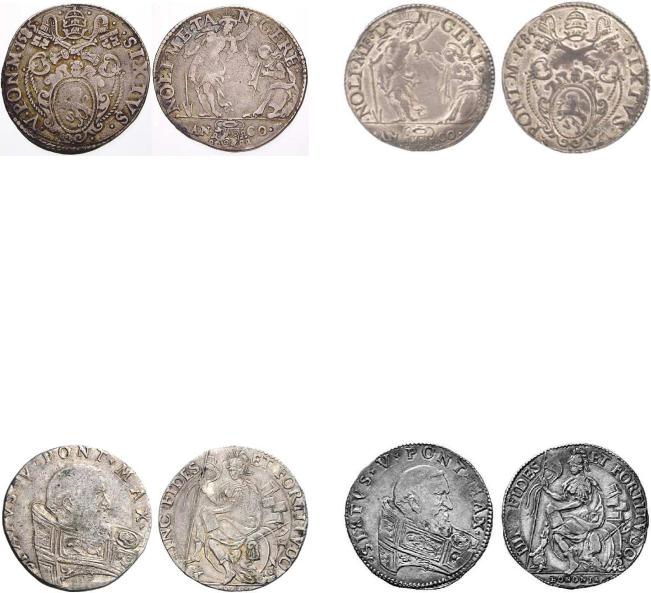
PAPAL COINS |
PAPAL COINS |
Sixtus V., 1585-1590. |
Sixtus V., 1585-1590. |
Testone. Ancona mint. 1585. |
Testone. Ancona mint. 1585. 9.34 g. |
Obv.: SIXTVS V PON M 1585 Coat of arms surmounted by crossed keys and papal tiara.
Rev.: NOLI ME TANGERE Nimbate Mary Magdalene in field right kneels to left before nimbate risen Christ, with his right hand raised, left hand holding downturned spear. In exurge coat of arms crowned by cardinal’s hat divides AN-CO.
Reference: Berman 1349; CNI 6; Muntoni 76. VF/F.
Estimation DM 250. Price realized: 575 DEM (approx. 261 U.S. Dollars as of the auction date)
PAPAL COINS
Sixtus V., 1585-1590.
Testone. Bologna mint. 32 mm 9.08 g.
Obv.: SIXTVS V PONT MAX Bust of pope right.
Rev.: HINC FIDES – ET FORTITVDO Felsina seated to left on shields, one foot on helmet, holding book and banner. In exurge: BONONIA (not toally visible here).
Reference: CNI 12. Muntoni 96. Berman 1360. VF.
Estimate: EUR 300. Price realized: 450 EUR (approx. 668 U.S. Dollars as of the auction date)
Obv.: SIXTVS V PONT M 1585 Coat of arms surmounted by crossed keys and papal tiara.
Rev.: NOLI ME TANGERE Nimbate Mary Magdalene in field right kneels to left before nimbate risen Christ, with his right hand raised, left hand holding downturned spear. In exurge coat of arms crowned by cardinal’s hat divides AN-CO.
Reference: (CNI 5; M 76 var; B 1349). Small scratch in the reverse field but a decent very fine and rare.
Estimate: £ 250.
PAPAL COINS
Sixtus V., 1585-1590.
Testone. Bologna mint. 33 mm 10,08 g.
Obv.: SIXTVS V PONT MAX Bust of pope right.
Rev.: HINC FIDES – ET FORTITVDO Felsina seated to left on shields, one foot on helmet, holding book and banner. In exurge: BONONIA
Reference: M 96. B 1260. VF.
Estimate CHF 600. Price realized: 750 CHF (approx. 554 U.S. Dollars as of the auction date)

PAPAL COINS
Sixtus V., 1585-1590.
Billon 6 blancs. 1587. Avignon. mint. 3,69 g.
Obv.: “S” topped with papal tiara. SIXTVS V PONTIF MAX 1587.
Rev.: Cross with fleur-de-lis ends. KA DE BOURBON CARD LEGA AVEN (referring to Charles, cardinal de Bourbon, legate.
Reference: B., 950; Munt., 88a; Berman, 1390; P.A., 4323. VF
Estimate: EUR 100. Price realized: 190 EUR (approx. 227 U.S. Dollars as of the auction date)
PAPAL COINS
Sixtus V., 1585-1590.
Billon 6 blancs. 1587. Avignon. mint. 4,16 g.
Obv.: “S” topped with papal tiara. Date below S. SIXTVS V PONTIF MAX
Rev.: Cross with fleur-de-lis ends. KA DE BOURBON CARD LEGA AVEN (referring to Charles, cardinal de Bourbon, legate.
Reference: B., 950; Munt., 88a; Berman, 1390; P.A., 4323. Irregular flan. F - VF
Estimate: EUR 75.
PAPAL COINS
Sixtus V., 1585-1590.
Billon 6 blancs. 1587. Avignon. mint. 3,82 g.
Obv.: “S” topped with papal tiara. SIXTVS V PONTIF MAX 1587.
Rev.: Cross with fleur-de-lis ends. KA DE BOURBON CARD LEGA AVEN (referring to Charles, cardinal de Bourbon, legate.
Reference: B., -; Munt., 103; Berman, 1392; P.A., -. Extremely rare. VF.
Estimate: EUR 500. Price realized: 400 EUR (approx. 478 U.S. Dollars as of the auction date)
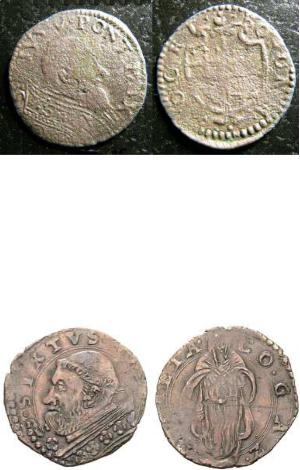
PAPAL COINS
Sixtus V., 1585-1590.
Sesino. 1587. Bologna mint.
Obv.: SIXTVS V PONT MAX Bust of pope right.
Rev.: Coat of arms DOCET BONONIA
Reference: Ber#1366 F+ slightly porous, Scarce
US$ 40.00.
PAPAL COINS
Sixtus V., 1585-1590.
AE Counterfeit of the Baiocchella. Bologna mint. 19 mm 1,09 g.
Obv.: Bust of pope left. SIXTVS [...}
Rev.: Veiled figure stands frontal.
Reference: CNI 12 var. MIR 316. Rare, VF.
Rara. BB
Estimate: EUR 70. Price realized: 220 EUR (approx. 293 U.S. Dollars as of the auction date)

Sede Vacante, 1590
PAPAL COINS
Sede Vacante, 1590.
Quattrino. Montalto mint.
Obv.: Papal tiara over crossed keys. SEDE VACANTE
Rev.: MON/TAL/TO in ribbon circle.
No.: 3676
o. J., . Tiara über gekreuzten Schlüsseln. Rv . Münzstättenname. 0,50 g. Munt. 17. Sehr schön.
Estimation: CHF 180. Price realized: 145 CHF (approx. 117 U.S. Dollars as of the auction date)
Urban VII - 15 Sept 1590 to 27 Sept 1590
Pope Urban VII (August 4, 1521 – September 27, 1590), born Giovanni Battista Castagna, was Pope for thirteen days in September 1590. He was of Genoese origin, although born in Rome. He was chosen successor of Pope Sixtus V (1585–90) on September 15, 1590, but died of malaria (September 27, 1590) before consecration, making his either the shortest or second shortest papal reign in history, depending on whether Pope-elect Stephen is considered a real Pope (he has not been so considered by the Catholic Church since 1961).
He had previously served as governor of Bologna and as archbishop of Rossano, and was for many years nuncio to Spain; his election to the papacy was largely backed by the Spanish faction.
Urban VII's short passage in office gave rise to the world's first known public smoking ban, as he threatened to excommunicate anyone who "took tobacco
in the porchway of or inside a church, whether it be by chewing it, smoking it with a pipe or sniffing it in powdered form through the nose".
PAPAL COINS
Urban VII (15-27 September 1590)
AE Sesino. Bologna mint. 18 mm 1,03 g.
Obv.: VRBANVS VII PON MAX Bust of pope right.
Rev.: Coat of arms, DOCET BONONIA
Reference: Munt. 3. Serafini 8. Berman 1410. Rare. About VF.
Estimate: EUR 200. Price realized: 350 EUR (approx. 466 U.S.
Dollars as of the auction date)
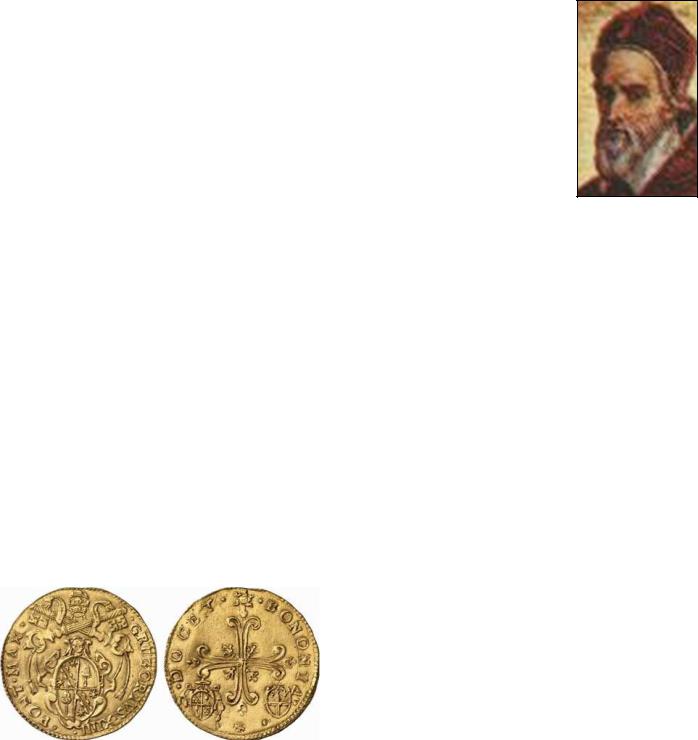
Gregory XIV - 5 Dec 1590 to 15 /16 Oct 1591
Pope Gregory XIV (February 11, 1535 – October 16, 1591), born Niccolò Sfondrati, was Pope from December 5, 1590 to October 16, 1591.
He was born at Somma Lombardo (now in the province of Varese, then part of the Duchy of Milan), in the highest stratum of Milanese society, but was known for his modest lifestyle and stringent piety. His mother, a Visconti, died in childbirth. His widower father Francesco, a senator of the ancient comune of Milan, was created cardinal by Pope Paul III (1534 – 1549), in 1544.
Niccolò studied at Perugia and Padua, was ordained as a priest, and swiftly appointed Bishop of Cremona, in 1560, in time to participate in the sessions of the Council of Trent from 1561 – 1563. Pope Gregory XIII (1572–85) made him a Cardinal-Priest of Santa Cecilia in Trastevere on December 12, 1583. He was a close follower of Carlo Borromeo, and when cardinal, he was an intimate friend and a great admirer of Philip Neri, an Italian priest who died in 1595 and was canonized in 1622.
The conclave after the death of Pope Urban VII (September 27, 1590) was a protracted one. At the outset, Olivares presented a list of the seven cardinals who would be acceptable to his master Philip II of Spain (1556 – 1598). Not until December 5, 1590, after two months of deadlock, was Sfondrati elected, one of Philip II's seven. Cardinal Montalto, who came to his cell to inform him that the Sacred College had agreed on his election, found him kneeling in prayer. When on the next day he was elected Pope Gregory XIV he burst into tears and said to the cardinals: "God forgive you! What have you done?" In his bull Cogit nos, (March 21, 1591), he forbade, under pain of excommunication, all bets concerning the election of a Pope, the duration of a pontificate, or the creation of new cardinals.
Gregory XIV's brief pontificate was marked by vigorous intervention in favor of the Catholic party in the French Wars of Religion. Instigated by the king of Spain and the duke of Mayenne, he excommunicated Henry IV of France (1589 – 1610) on March 1, 1591, reiterating the declaration of Pope Sixtus V (1585) that as a heretic Henry of Navarre was excluded from the succession to the throne of France, and declaring him to be deprived of his dominions. Gregory XIV also levied an army for the invasion of France and dispatched his nephew Ercole Sfondrati to France at its head and sent a monthly subsidy of 15,000 scudi to Paris, to reinforce the Catholic League. Thus was abandoned the recent papal policy of trying to maintain a balance between Spain and France, coming down solidly on the side of Spanish interests, in part because Gregory XIV was elected due to the influence of the Spanish cardinals. Gregory XIV created five Cardinals, among whom was his nephew Paolo Emilio Sfondrati, his Secretary of State. He attempted to convince Philip Neri, a long-time friend, to accept the post of Cardinal, but Neri refused, saying that there were many more deserving of the honour than him.
In a decree dated 18 April 1591, Gregory XIV ordered reparations to be made by Catholics in the Philippines to the natives, who had been forced into slavery by Europeans, and commanded under pain of excommunication that all native slaves in the islands should be set free (though African slaves were apparently still permitted). The biographers mention as a curious personal trait of Pope Gregory XIV: a nervous tendency to laughter which occasionally became irresistible, and which manifested itself even at his coronation. Gregory, who was in poor health even before his election to the papacy, was succeeded by Innocent IX after he died due to a large gallstone.
PAPAL COINS
Gregory XIV., 1590-1591.
Doppia. Bologna mint. 6,60 g.
Obv.: GREGORIVS XVVVV PONT MAX Coat of arms surmounted by crossed k eys and papal tiara.
Rev.: Floreate cross, flanked by shields at lower end. DOCET BONONIA
Reference: Fb. 355; Muntoni 3. GOLD. Extremely rare. VF/XF.
Estimate: 7500 EUR. Price realized: 13,000 EUR (approx. 19,926 U.S. Dollars as of the auction date)
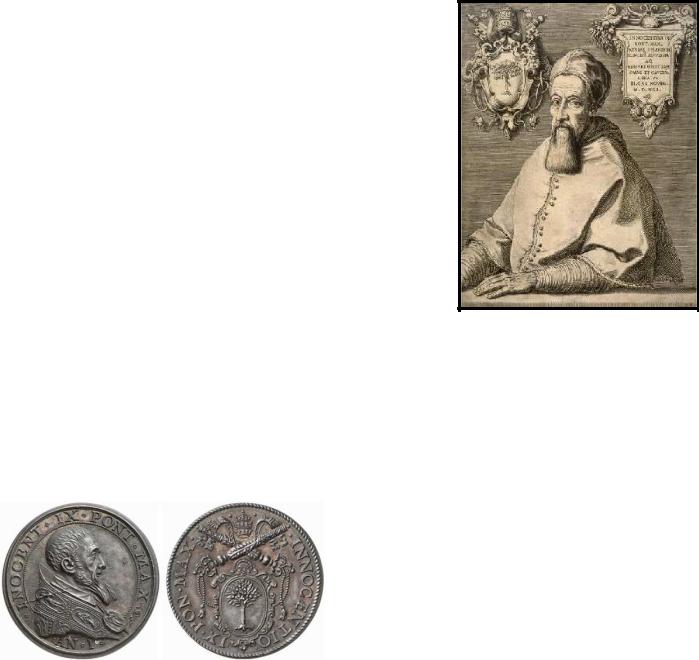
Innocent IX - 29 Oct 1591 to 30 Dec 1591
Pope Innocent IX (July 20, 1519 – December 30, 1591), born Giovanni Antonio Facchinetti, was Pope from October 29, 1591 through his death on December 30 of the same year. Prior to his short papacy, he had been a Canon Lawyer, diplomat, and chief administrator during the reign of Pope Gregory XIV (1590-1591).
Facchinetti was born in Crodo, in the diocese of Novara, northern Italy. He was a lawyer, a graduate in 1544 of the University of Bologna, which was pre-eminent in jurisprudence, and became secretary to Cardinal NicolòArdinghelli before entering the service of Cardinal Alessandro Farnese, brother of the Duke of Parma and nephew of Pope Paul III (1534-1549), one of the great patrons of the time. The Cardinal, who was archbishop of Avignon, sent Facchinetti there as his ecclesiastical representative and subsequently recalled him to the management of his affairs at Parma, where he was acting governor of the city, from 1556 to 1558. In 1560, Facchinetti was named Bishop of Nicastro, in Calabria, and in 1562 was present at the Council of Trent. Pope Pius V (1566-1572) sent him as papal nuncio to Venice in 1566 to further the papal alliance with Spain and Venice against the Turks, which ultimately resulted in the victory of Lepanto in 1571. Relinquishing his see to pursue his career in Rome, he was named titular Latin Patriarch of Jerusalem in 1572.
During the reign of the sickly Gregory XIV, who suffered from bouts of malaria, the burden of the papal administration rested on his shoulders. Even before Gregory XIV breathed his last, Spanish and anti-Spanish factions were electioneering for the next
Pope. Philip II of Spain's (1556-1598) high-handed interference at the previous conclave was not forgotten: he had barred all but seven cardinals. This time the Spanish party in the College of Cardinals did not go so far, but they still controlled a majority, and after a quick conclave they raised Facchinetti to the papal chair as Pope Innocent IX. Mindful of the origin of his success, Innocent IX supported, during his two months' pontificate, the cause of Philip II and the Catholic League against Henry IV of France (15891610) in the civil Wars of Religion (1562-1598), where a papal army was in the field. Death, however, did not permit the realization of Innocent IX's schemes.
His great-nephew Cardinal Giovanni Antonio Facchinetti de Nuce, juniore, was one of two Cardinals appointed during the weeks of Innocent IX's pontificate. A later member of the Cardinalate was his great-grand-nephew Cesare Facchinetti (made a Cardinal in 1643).
PAPAL COINS
Innocent IX., 1591
Bronze medal 1591. 31 mm.
Obv.: INOCENT IX PONT MAX Bust of pope right. ANNO I below bust.
Rev.: INNOCENTIO IX PON MAX Coat of arms surmounted by crossed keys and papal tiara.
Reference: Spink 828 XF.
Starting Price EUR 30. Price realized: 70 EUR (approx. 102 U.S. Dollars as of the auction date)

Clement VIII - 30 Jan 1592 to 3 March 1605
Pope Clement VIII (February 24, 1536 – March 3, 1605), born Ippolito Aldobrandini, was Pope from January 30, 1592 to March 3, 1605.
Born at Fano to a distinguished Florentine family, he studied law under his father, an able jurist; his ecclesiastical career was as a lawyer: consistorial advocate, auditor of the Rota and the Datary.
He was made a cardinal 1584 and sent him as legate in Poland. He placed himself under the direction of the reformer Philip Neri, who for thirty years was his confessor. Aldobrandini won the gratitude of the Habsburgs by his successful diplomatic efforts in Poland to obtain the release of the imprisoned Archduke Maximilian, the defeated claimant to the Polish throne.
After the death of Pope Innocent IX (1591), another stormy conclave ensued, where a determined minority of Italian Cardinals were unwilling to be dictated to by Philip II of Spain. Cardinal Aldobrandini's election on January 30, 1592, was received as a portent of more balanced and liberal Papal policy in European affairs. He took the nonpoliticized name Clement VIII. He proved to be an able Pope, with an unlimited capac-
ity for work and a lawyer's eye for detail, and a wise statesman, the general object of whose policy was to free the Papacy from its dependence upon Spain.
In 1597, he established the Congregatio de Auxiliis which was to settle the theological controversy between the Dominican Order and the Jesuits concerning the respective role of efficacious grace and free will. Although the debate tended toward a condemnation of Molinism's insistence on free will to the detriment of efficacious grace, the important influence of the Jesuit Order — among other considerations — which, beside import ant political and theological power in Europe, had also various missions abroad (Jesuit Reducciones in South America, missions in China, etc.), led the Pope to abstain from an official condemnation of the Jesuits. In 1611 and again in 1625 a decree prohibited any discussion of the matter, although it was often unformally avoided by the publication of commentaries of Thomas Aquinas.
During the jubilee of 1600, three million pilgrims visited the holy places. The Synod of Brest was held 1595 in Lithuania, by which a great part of the Ruthenian clergy and people were reunited to Rome.
Clement VIII presided at the conferences to determine the questions of grace and free will, controverted between the Jesuits and Dominicans, were commenced under him, but he abstained from pronouncing a decision.
On February 17, 1600, Giordano Bruno, a strong believer of free will, was burned alive due to Clement VIII's approval of a guilty verdict against Bruno.
Clement VIII canonized Hyacinth (17 April 1594) and Raymond of Peñafort (1601).
The most remarkable event of Clement VIII's reign was the reconciliation to the Church of Henry IV of France (1589–1610), after long negotiations, carried on with great dexterity through Cardinal Arnaud d'Ossat, that resolved the complicated situation in France. Henry embraced Catholicism on July 25, 1593. After a pause to assess Henry IV's sincerity, Clement VIII braved Spanish displeasure, and in the autumn of 1595 he solemnly absolved Henry IV, thus putting an end to the thirty years' religious war in France and winning a powerful ally.
Henry IV's friendship was of essential importance to the Papacy two years later, when Alfonso II, Duke of Ferrara, died childless (October 27, 1597), and the Pope resolved to attach the stronghold of the Este family to the states of the Church. Though Spain and the Empire encouraged Alfonso II's illegitimate cousin, Cesare d'Este, to withstand the Pope, they were deterred from giving him any material aid by Henry IV's threats, and a papal army entered Ferrara almost unopposed.
Clement VIII was as merciless as Pope Sixtus V (1585–90) in crushing brigandage in central Italy and in punishing the lawlessness of the Roman nobility. He did not even spare the youthful parricide Beatrice Cenci, who was to become a popular heroine adapted in literature by Stendhal, Giorgio Moravia, and Percy Bysshe Shelley. In 1600 Giordano Bruno was burned at the stake in the Campo de' Fiori. The year before, the miller Menocchio, who had created a cosmology all by himself, holding that all life evolved like rotten cheese, was also put to the stake.

Clement VIII was also openly anti-semitic, making the usual link of Jews and usury:
All the world suffers from the usury of the Jews, their monopolies and deceit. They have brought many unfortunate people into a state of poverty, especially the farmers, working class people and the very poor. Then as now Jews have to be reminded intermittently anew that they were enjoying rights in any country since they left Palestine and the Arabian desert, and subsequently their ethical and moral doctrines as well as their deeds rightly deserve to be exposed to criticism in whatever country they happen to live.
Clement VIII's approach towards the Jews had more specific targets. In Cum saepe accidere (February 28, 1592) he forbid the long-established Jewish community of the papal enclave of Avignon to sell new goods, putting them at a disadvantage and fostering the cliché of the Jew as a dealer in secondhand goods. With Caeca et obdurata (February 25, 1593) he confirmed the bull of Pope Paul III (1534–49) that established a ghetto for the ancient community of Jews in Rome, and reiterated the ban on Jews, who had otherwise been formally expelled from the Papal States by Pope Pius V (1566–72) (in Hebraeorum gens, February 26, 1569) dwelling outside of the ghettos of Rome, Ancona, and Avignon, thus ensuring that they remained city-dwellers. Beyond Papal reach, east of Poland, by contrast, farming communities of Jews remained a familiar feature of the landscape. With Cum Haebraeorum malitia a few days later (February 28) he even forbade the reading of the Talmud [1]. It is alleged that Clement VIII's reference to the "blind (Latin: caeca) obstinacy" of the Jews gave rise to the religious slur "kike", though many etymologies dispute this.
Clement VIII was afflicted by gout, and was forced to spend much of his later life immobilized in bed. He died in March of 1605, leaving a reputation for prudence, munificence, and capacity for business. His reign is especially distinguished by the number and beauty of his medals, and especially tarnished by his role in the brutal execution of Giordano Bruno, one of the great minds of his time. Clement was buried in St. Peter's Basilica, and later Pope Paul V (1605–21) had a mausoleum built for him in the Borghese Chapel of Santa Maria Maggiore, where the remains were transferred in 1646.
Clement VIII founded the Collegio Clementino for the education of the sons of the richer classes, and augmented the number of national colleges in Rome by opening the Collegio Scozzese for the training of missionaries to Scotland.
PAPAL COINS
Clement VIII., 1592-1605..
Doppia. Bologna mint. 6,62 g.
Obv.: CLEMENS VIII PONT MAX Coat of arms surmounted by crossed keys and papal tiara.
Rev.: Floreate cross, flanked by shields at lower end. DOCET BONONIA
Reference: Fb. 357; Muntoni 119. GOLD. Extremely rare. Plugged hole. Some rim damage. VF.
Estimate: 2000 EUR. Price realized: 1,900 EUR (approx. 2,912 U.S. Dollars as of the auction date)
PAPAL COINS
Clement VIII., 1592-1605..
Piastra. 1599. Avignon mint. 31,31 g.
Obv.: CLEMENS VIII PONT MAX 1599 Bust of pope left.
Rev.: OCTAVIVS CARD D AQVAVIVA LEGA AVENIO around coat of arms topped with cardinal’s hat.
Reference: Dav. 8336; Muntoni 90. Extremely rare, small scratches and rim damage. Overall VF.
Estimate: 5,000,00 EUR. Price realized: 9,500 EUR (approx. 10,899 U.S. Dollars as of the auction date)
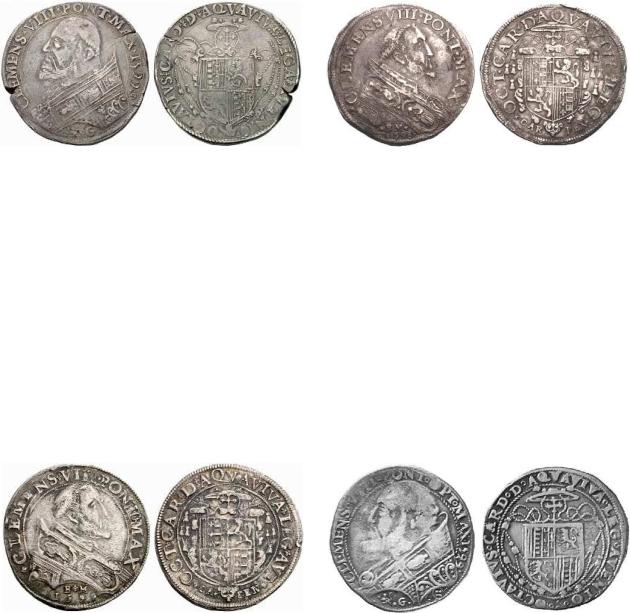
PAPAL COINS
Clement VIII., 1592-1605..
Piastra. 1599. Avignon mint. 44 mm 31,71 g.
Obv.: CLEMENS VIII PONT MAX 1599 Bust of pope left. G (mintmaster’s initial) beneath bust.
Rev.: OCTAVIVS CARD D AQVAVIVA LEGA AVENIO around coat of arms topped with cardinal’s hat.
Reference: Muntoni 93. Spaziani Testa 17. Berman 1500. Poey d’Avant 4350. Davenport 8338. Extremely rare, small rim fracture, VF+
Estimate: EUR 10000. Price realized: 9,500 EUR (approx. 10,899 U.S. Dollars as of the auction date)
PAPAL COINS
Clement VIII., 1592-1605..
Piastra. 1599. Carpentrasso mint. 45 mm 31,67 g.
Obv.: CLEMENS VIII PONT MAX Bust of pope right. BM (mintmaster’s initials)/1599 beneath bust.
Rev.: OCT CAR D AQVAVIVA LEG AVE around coat of arms topped with cardinal’s hat. CAR-PEN below arms.
Reference: Spaziani-Testa 22. Muntoni 130. Berman 1523.
Very rare. VF+
Estimate: EUR 12000. Price realized: 16,000 EUR (approx. 23,742 U.S. Dollars as of the auction date)
PAPAL COINS
Clement VIII., 1592-1605..
Piastra. 1598. Carpentrasso mint. 42 mm 31,34 g.
Obv.: CLEMENS VIII PONT MAX Bust of pope right. BM (mintmaster’s initials)/1598 beneath bust.
Rev.: OCT CAR D AQVAVIVA LEG around coat of arms topped with cardinal’s hat. CAR-PEN below arms.
Reference: Muntoni 128. Spaziani Testa 21 (R7). Serafini Vol.IV 415/a301. Cinagli 17. Scilla 16. Berman 1523. Davenport 8339. Very rare, some corrosion traces. VF.
Estimate: CHF 20000. Price realized: 26,500 CHF (approx. 21,033 U.S. Dollars as of the auction date)
PAPAL COINS
Clement VIII., 1592-1605..
1/2-Piastra. 1599. Avignon mint.
Obv.: CLEMENS VIII PONT MAX 1599 Bust of pope left. G (mintmaster’s initial) beneath bust.
Rev.: OCTAVIVS CARD D AQVAVIVA LEGA AVENIO around coat of arms topped with cardinal’s hat.
Reference: Muntoni 97. Extremely rare. F/VF.
Estimation: EUR 600. Price realized: 1,100 EUR (approx. 963 U.S. Dollars as of the auction date)
